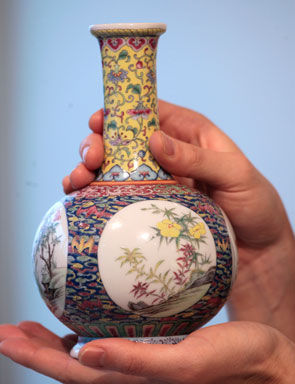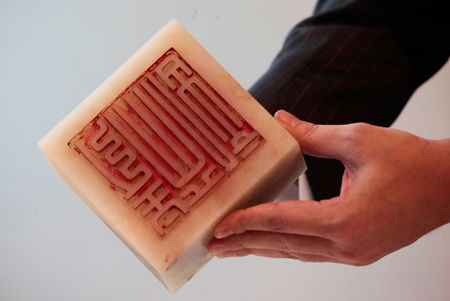Sotheby's to Offer a Unique Collection of Imperial Porcelain
An Exceptional Floral Medallion Vases Enamelled in the Imperial Workshops. The work is estimated to fetch 60-80 million Hong Kong dollars or about 7.71 -10.2 million US dollars. EPA/YM YIK.
HONG KONG.- Sotheby’s Hong Kong will hold an unprecedented sale of Chinese ceramics and works of art, titled Masterpieces Of Qing Imperial Porcelain From J.T. Tai & Co., on 7 October 2010 at the Hong Kong Convention and Exhibition Centre, comprising 13 lots and expected to bring in excess of HK$170 million/US$22 million. The second part of the collection will be offered at Sotheby’s New York during its Asia Week in March, 2011.
The imperial Chinese porcelains from the J.T. Tai Foundation features eight vases made during the peak period of imperial porcelain production under the Qianlong Emperor, one of China’s greatest art lovers and imperial patrons, each of which boasts a collecting history in the West traceable to the 19th century.
The highlight in the present group is an exceptional Pair of Floral Medallion Vases Enamelled in the Imperial Workshops (Est. HK$60–80 million and HK$8– 10 million; the vases are offered as two individual lots), exquisitely enamelled with Flowers of the Four Seasons. The floral scenes are reminiscent of Beijing-enamelled glass, the scrollwork on the neck of Beijing-enamelled copper, which would have been executed in the same workshops, by the same painters. Porcelains painted in Beijing are generally unique, pairs are not identical but complementary, so both vases show the same flowers but in different compositions.
Other vases in the group come from Fonthill House, one of the grand English country estates, from the collection of Alfred Morrison (1821–97). Porcelain painters at Jingdezhen adopted techniques developed at Beijing in the early Qianlong reign, and it resulted in the most sumptuous porcelain decoration. Sgraffiato work, where a formal design is carved into a solid background colour, was perfected at Jingdezhen: scrollwork engraved with a needlepoint conveyed an impression of rich brocade. A particularly elegant specimen is the Yellow-Ground Famille-Rose Double-Gourd Vase (Est. HK$30–50 million), the production of which would have required multiple overlapping of the different colours and formidable organization of the design.
Roughly contemporary and yet different in style is A Robin’s Egg-Ground Gilt-Decorated Archaistic Vase (Est.HK$18–25 million) with stylised dragons vaguely inspired by archaic ritual bronzes of the Western Zhou period (circa 1050–771 BCE). The mottled turquoise glaze that forms the background to the coffee-brown relief design evokes the blue-green patina of ancient metalwork. The quality and variety of the J. T. Tai vases provide an unparalleled glimpse into the craftsmanship and stylistic range of Chinese potters at their most ambitious period.
J. T. Tai (1910-1992)
In late 1920s, Tai Jun Tsei, or J. T. Tai (1910-1992) became an apprentice to his Uncle Chin, his mother’s brother, at his antique shop in Wuxi, where J. T. Tai was brought up. He clearly had a good eye and business acumen, because in due course he was given the responsibility of travelling to neighbouring provinces to buy stock.
In the 1930s, he moved to Shanghai and opened his own shop and, in January 1932, he married Chang Ping Ying. However, the advancing Japanese invasion progressively removed all possibility of a normal life culminating in the brutal battle of Shanghai in1937. He and his family finally left Shanghai in April 1949 for Hong Kong and he never again returned to his home country.
With China now closed to the world for any art business Hong Kong must have had limited scope for an ambitious young man. Inevitably J. T. Tai was drawn to the markets of America and Europe, and in 1950 he took the bold decision to make the move to New York.
In the spring of 1953, he flew to France and England on his first buying trip. On 24th March he attended the sale of Ming Ceramics from the collection of Mrs Alfred Clarke at Sotheby’s London. The inscrutable Chinese man from New York was an exotic and remarkable addition to the occasion, buying eleven lots and some of the best pieces.
He returned to London many times during the 1960s and 1970s, as he became the greatest of a new post war generation of Chinese art dealers. He was very knowledgeable about pottery and porcelain so at the sale of the collection made by the London dealer H. R. Norton in November 1963 he purchased the star of the collection. This was a superb 15th Century blue and white Meiping with its original cover for the then world record price of £8,000. He made it his business to seek out collectors who had both the enthusiasm and the resources to create sensational collections. The two with whom he worked most closely were Avery Brundage, whose remarkable collection forms the core of the Asian Art Museum in San Francisco and Arthur Sackler whose collection is substantially housed in the Arthur M. Sackler Museum in Washington.
In 1982 Mr Tai set up The J. T. Tai & Co. Foundation, Inc., which under his direction began by sponsoring medical students before spreading its grants to include medical research, the American Red Cross and many other charities. It also made a number of donations to Peking University, Beijing and to SooChow University, Taiwan. The Foundation will benefit from these auctions and will continue to give generously to the causes which Tai Jun Tsei himself chose.
Nicolas Chow, Sotheby's Deputy Chairman and International Head of Chinese Ceramics and Works of Art showing a Massive Qianlong Imperial White Jade 'Xintian Zhuren' Seal, Qing Dynasty during a press preview in Hong Kong, China. The Seal will be auctioned as part of the total estimate over 780 million Hong Kong dollars or about 100 million US dollars at Sotheby's Fine Chinese Ceramics and Works of Art Autumn Sale on 7-8 October, and the work is estimated to fetch 25-30 million Hong Kong dollars or about 3.21-3.85 million US dollars. EPA/YM YIK .

/https%3A%2F%2Fprofilepics.canalblog.com%2Fprofilepics%2F1%2F0%2F100183.jpg)
/https%3A%2F%2Fstorage.canalblog.com%2F03%2F02%2F119589%2F96711876_o.jpg)
/https%3A%2F%2Fstorage.canalblog.com%2F11%2F31%2F119589%2F94773502_o.jpg)
/https%3A%2F%2Fstorage.canalblog.com%2F20%2F83%2F119589%2F94772815_o.jpg)
/https%3A%2F%2Fstorage.canalblog.com%2F26%2F72%2F119589%2F75604929_o.jpg)
/https%3A%2F%2Fstorage.canalblog.com%2F59%2F60%2F119589%2F26458628_o.jpg)




/image%2F1371349%2F20240426%2Fob_afd75f_telechargement-20.jpg)
/image%2F1371349%2F20240426%2Fob_b8573a_telechargement-15.jpg)
/image%2F1371349%2F20240426%2Fob_abde48_telechargement-12.jpg)
/image%2F1371349%2F20240426%2Fob_89213c_telechargement-7.jpg)